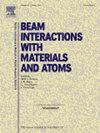Influence of 1 MeV electron irradiation on the output parameters of silicon heterojunction solar cells
IF 1.4
3区 物理与天体物理
Q3 INSTRUMENTS & INSTRUMENTATION
Nuclear Instruments & Methods in Physics Research Section B-beam Interactions With Materials and Atoms
Pub Date : 2025-01-31
DOI:10.1016/j.nimb.2025.165630
引用次数: 0
Abstract
In this study, influence of electron irradiation with an energy 1 MeV on the output photovoltaic parameters of n-type silicon heterojunction solar cells has been investigated. It has been shown that when irradiated with electrons fluence of 5 × 1014 e/cm2, a significant decrease in the quantum efficiency occurs at wavelengths of longer than 600 nm, leading to a decrease in the short-circuit current from 33.1 to 22 mA/cm2 and the open-circuit voltage from 0.68 to 0.53 V, and at a fluence of 1 × 1015 e/cm2 down to 18.3 mA/cm2 and 0.51 V respectively. Moreover, the surface recombination velocities of ∼500 cm/s at 5 × 1014 e/cm2 and ∼580 cm/s at 1 × 1015 e/cm2 have been calculated from the load current–voltage characteristics, i.e., ∼16 cm/s before irradiation. Based on capacitance–voltage measurements decrease in charge carrier concentration from 1015 cm−3 to 8.15 × 1014 cm−3 in the bulk of a silicon heterojunction solar cells after electron irradiation at different fluences ( e/cm2), whereas the carrier removal rate of Rc ≈ 0.21 cm−1 were calculated.
1mev电子辐照对硅异质结太阳能电池输出参数的影响
本文研究了能量为1 MeV的电子辐照对n型硅异质结太阳能电池输出光伏参数的影响。结果表明,当电子辐照强度为5 × 1014 e/cm2时,波长大于600 nm处量子效率显著降低,导致短路电流从33.1 mA/cm2降至22 mA/cm2,开路电压从0.68 V降至0.53 V,当电子辐照强度为1 × 1015 e/cm2时,短路电流降至18.3 mA/cm2,开路电压降至0.51 V。此外,根据辐照前负载电流-电压特性,即辐照前的~ 16 cm/s,计算出5 × 1014 e/cm2下的~ 500 cm/s和1 × 1015 e/cm2下的~ 580 cm/s的表面复合速度。基于电容电压测量,在不同影响(ϕ=1015 e/cm2)下,硅异质结太阳能电池体中载流子浓度从1015 cm−3下降到8.15 × 1014 cm−3,而载流子去除率Rc≈0.21 cm−1。
本文章由计算机程序翻译,如有差异,请以英文原文为准。
求助全文
约1分钟内获得全文
求助全文
来源期刊
CiteScore
2.80
自引率
7.70%
发文量
231
审稿时长
1.9 months
期刊介绍:
Section B of Nuclear Instruments and Methods in Physics Research covers all aspects of the interaction of energetic beams with atoms, molecules and aggregate forms of matter. This includes ion beam analysis and ion beam modification of materials as well as basic data of importance for these studies. Topics of general interest include: atomic collisions in solids, particle channelling, all aspects of collision cascades, the modification of materials by energetic beams, ion implantation, irradiation - induced changes in materials, the physics and chemistry of beam interactions and the analysis of materials by all forms of energetic radiation. Modification by ion, laser and electron beams for the study of electronic materials, metals, ceramics, insulators, polymers and other important and new materials systems are included. Related studies, such as the application of ion beam analysis to biological, archaeological and geological samples as well as applications to solve problems in planetary science are also welcome. Energetic beams of interest include atomic and molecular ions, neutrons, positrons and muons, plasmas directed at surfaces, electron and photon beams, including laser treated surfaces and studies of solids by photon radiation from rotating anodes, synchrotrons, etc. In addition, the interaction between various forms of radiation and radiation-induced deposition processes are relevant.

 求助内容:
求助内容: 应助结果提醒方式:
应助结果提醒方式:


